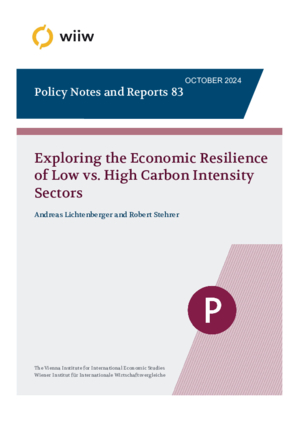Exploring the Economic Resilience of Low vs. High Carbon Intensity Sectors
Andreas Lichtenberger and Robert Stehrer
wiiw Policy Note/Policy Report No. 83, October 2024
23 pages including 2 Tables and 10 Figures
This study investigates the comparative economic resilience of low carbon intensity (LCI) versus high carbon intensity (HCI) industries of the Austrian economy, examining the impact of energy price shocks on real gross value added (GVA) and employment within both LCI and HCI industries. To illustrate these dynamics, we conducted a vector autoregression (VAR) analysis to simulate the effects of various energy price shocks on key economic indicators, comparable to the price surge experienced at the start of the war in Ukraine. The results show that fossil energy price dynamics can lead to significant economic damage, such as a loss in the dimension of 6.6% in real GVA in the HCI sector one year after a gas price shock (reflecting a possible loss of EUR 10 billion) or a loss in the range of 3-4% of jobs in the HCI sector for individual years after the shock (i.e., about job 50-70 thousand jobs in certain years). We argue that LCI industries demonstrate greater resilience in the light of fossil energy price shocks, which appear to destabilise HCI industries to a higher degree at least in the short run, not accounting for other factors and considering that everything else is kept constant. In conclusion, this study underscores the necessity for policy makers to prioritise the transition to low-carbon industries.
Reference to wiiw databases: wiiw Annual Database
Keywords: green transition, energy price shocks, I/O-sector-analysis, VAR, GDP, GVA, employment, climate policy
JEL classification: Q41, Q43, C22, D57, E61, O44
Countries covered: Austria
Research Areas: Macroeconomic Analysis and Policy, Sectoral studies
